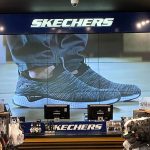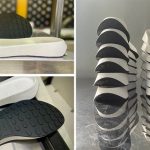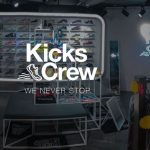If one product category had to be picked out of the entire array of goods at Interbike as the main theme of the show it would have to be the chopper. The 2004 show saw more new companies producing choppers and product line extensions into the category than ever before. There were so many scattered throughout the isles, from custom built one-offs to the mass produced Schwinn Stingray, that many people walking the show were calling it the “Year of the Chopper.”
There were countless independent manufacturers showing there new stretched and laid back hot-rods, and even some of the larger players entered the game, with models from Felt, Giant, and Marin gracing the booths. Several larger manufacturers even entered the one-off game, making custom bikes that could put several Harley owners to shame.
While the new Schwinn Stingray, designed by Orange County Choppers, certainly didnt start this trend, the company is claiming a certain amount of ownership over it due to their being the first company to mass merchandise a chopper.
“Walking around and seeing all of these choppers is a little disconcerting,” said Mo Moorman, VP of Marketing and PR at Pacific Cycles. “I guess that imitation is the most sincere form of flattery after all.”
Moorman said that the Stingray has exceeded all of their greatest expectations. “We were originally forecasting around 70,000 units sold,” he said. “Now, I dont want to say it because it sounds so outrageous, but sales will be seven or eight times that.”
Pacific has also begun the process of introducing product extensions to the Stingray, with several models to fit adults of children ranging from a 20-inch wheel down to a 12 inch wheel. Some of the newer models are even equipped with a “suicide” styled rear derailer shifter.
Moorman admits that the company, and the Schwinn brand in particular, is having a tough time with Independent Bike Dealers, but he says that the bicycle community is slowly returning to Schwinn. Judging by the booth traffic, things are picking up. Last year the company had the same booth, and several reps were standing around with few customers in sight. This year everyone was either showing the line or writing orders.
Several retailers that BOSS spoke with said they thought Schwinn “got lucky” with the Stingray, but judging from the predictions made by Dorels president when they bought the brand earlier this year, the team at Pacific knew they had a winner before the product shipped to retailers.
The OutDoor Demo was a raging success by all accounts. Day one was very steady for most of the vendors BOSS spoke with, even though many retailers decided to stay home an extra day and wait until Day 2. For the people who really wanted to ride bikes it paid to show up early. While there was some waiting on the first day, it was easy to step next door and grab another model while you waited for a specific bike to become free. On the second day the lines were so long, most people were waiting at least 30 minutes to get a demo.
The most evident trend at the demo was the refinement of ride quality among carbon fiber bikes. The manufacturers who have been working with carbon for some time are now able to tweak the materials characteristics to make a frame behave any way you can imagine.
While many companies were showing off their high-end models, Giant had a great display of this ability to tune carbon. The company had two road models in a side-by side comparison a more relaxed comfort-oriented road bike, the OCR, and their team racing model, the TCR. Ridden one after the other certainly highlighted the variety of ride characteristics attainable with carbon.
The manipulation of traditional bicycle shapes, which carbon has also made possible, is giving frame-builders the ability to add a little more style to what is already considered by many to be a blend between craft and art. The general trend among some of the leading companies seems to be towards a more fluid shape, while at the same time trending towards an industrial look.
This may sound like a dichotomy, but when you look at companies like Giant and Specialized who are adding sweeping arched top-tubes to their frames, while at the same time, Specialized, Kestrel, and Cervelo are adding details like highlighted lugs, and making the joints of their frames more angular and industrial, the trend becomes clear.
Some saddle companies are following this trend as well with Selle Italia introducing a saddle last year that blends the modern sleek silhouette of its SLR line with the old-world industrial look of Brass rivets and natural-colored leather.
The retro trend that was characterized by wool jerseys and mid 1900s team logos, seems to have tapered out a bit, although there are still some strong offerings in the category from companies like Canari and Descent North America.
Canari is continuing on their successful marketing strategy. BOSS spoke with Chris Robinson, Vice President at Canari, who said that when he joined the company, it was almost a commodity product. The new management team focused on building the brand to add value to the product, and has since signed several licensing agreements with Arrogant Bastard Ale, Campbells, and Rat Fink. Now Robinson said that the company is focusing on the performance aspects of their clothing, and this is bringing more licensing deals their way.
BOSS also spoke with Paul Done, the Voice of Sugoi, who said that his company re-organizing their apparel line for 05 into three distinct categories called Athletic Power for high performance racing cyclists, Core Function for every-day enthusiasts, and Alternative Performance for cyclists who want a baggier fit with all of the benefits of performance fabric.
The new organization gives retailers better guidance on which items to buy and which to eliminate depending on their target customer. Done said that Sugoi has really been seeing an increase in participation in larger group events like century rides and marathon MTB festivals.
While most of the buzz was around the road scene, there are some developments in Mountain biking. Most of the vendors BOSS spoke with said that the All Mountain category is one of the few areas in the mountain bike world showing some growth. Several companies are extending their product by either tweaking their XC models to be heavier with slightly longer travel, or toning down their free-ride models.
The end result is a 25-27 pound bike that has four to six inches of travel in the front and rear. The idea is to have a fun freeride style bike that can still be pedaled up a hill. Most manufacturers agreed that this new style of mountain biking would not be possible without the SPV platform invented by the engineers at Progressive/5th Element, and now licensed by Manitou. Other companies are getting into the category without this technology, but are forced to rely on awkward suspension lock-outs.
Overall the show had a very positive feel to it, although the energy may not have been as high as in years past. Several people BOSS spoke with thought that two things were contributing to this, both involving athletes. First of all, the anticipation of will Lance do it was missing this year since he already did it. This really isnt so much a negative but rather the lack of some positive energy.
The second was the shadow hanging over Tyler Hamilton. Many people in the industry feel that if Tyler is found to be guilty of doping then the whole professional peloton is guilty. This may or may not have an effect on participation in road biking, but it will certainly make it more difficult for professional teams, both European and domestic, to find sponsors. In the end, this may give networks like OLN some pause when deciding about covering cycling.
Some of that concern may have been blunted a bit after Compex Technologies announced they signed Hamilton to a sponsorship deal. Compex designed and markets electro-muscle stimulation (e-stim) sports and fitness products. Compex said Hamilton started using their product early this year as part of his training regimen in preparation for the 2004 racing season.














